Augmented Reality Applications for Learning Geography in Primary Education
Abstract
:1. Introduction
2. Literature Review
3. AR Geography Applications
3.1. AR App for 5th Grade: Greece
3.2. AR App for 6th Grade: Earth as a Living Space for Humans
3.3. AR App for 6th grade: Earth as a Celestial Body
4. Method
4.1. Participants
4.2. Procedure and Material
5. Results and Discussion
5.1. Evaluation of Quantitative Method
5.2. Evaluation of Qualitative Method
6. Conclusions and Future Work
Supplementary Materials
Author Contributions
Funding
Data Availability Statement
Acknowledgments
Conflicts of Interest
References
- Azuma, R.T. A Survey of Augmented Reality. Presence Teleoperators Virtual Environ. 1997, 6, 355–385. [Google Scholar] [CrossRef]
- Ramnarain-Seetohul, V.; Nishesh, A.; Siddish, L. Enhancing Learning at Primary School Through Augmented Reality. In Smart and Sustainable Engineering for Next Generation Applications; Fleming, P., Lacquet, B., Sanei, S., Deb, K., Jakobsson, A., Eds.; ELECOM 2018; Lecture Notes in Electrical Engineering; Springer: Cham, Switzerland, 2019. [Google Scholar]
- Cerqueira, C.S.; Kirner, C. Developing Educational Applications with a Non-Programming Augmented Reality Authoring Tool. In Proceedings of the World Conference on Educational Multimedia, Hypermedia and Telecommunications, Denver, CO, USA, 26 June 2012. [Google Scholar]
- Tobar-Muñoz, H.; Baldiris, S.; Fabregat, R. Augmented reality game-based learning: Enriching students’ experience during reading comprehension activities. J. Educ. Comput. Res. 2017, 55, 901–936. [Google Scholar] [CrossRef]
- Kazanidis, I.; Palaigeorgiou, G.; Chintiadis, P.; Tsinakos, A. A Pilot Evaluation of a Virtual Reality Educational Game for History Learning. In Proceedings of the European Conference on e-Learning, Athens, Greece, 1–2 November 2018; pp. 245–253. [Google Scholar]
- Efstathiou, I.; Kyza, E.A.; Georgiou, Y. An inquiry-based augmented reality mobile learning approach to fostering Primary school students’ historical reasoning in non-formal settings. Interact. Learn. Environ. 2017, 26, 22–41. [Google Scholar] [CrossRef]
- Cai, S.; Chiang, F.-K.; Sun, Y.; Lin, C.; Lee, J.J. Applications of augmented reality-based natural interactive learning in magnetic field instruction. Interact. Learn. Environ. 2016, 25, 778–791. [Google Scholar] [CrossRef]
- Zafeiropoulou, M.; Volioti, C.; Keramopoulos, E.; Sapounidis, T. Developing Physics Experiments Using Augmented Reality Game-Based Learning Approach: A Pilot Study in Primary School. Computers 2021, 10, 126. [Google Scholar] [CrossRef]
- Cai, S.; Chiang, F.; Wang, X. Using the Augmented Reality 3D Technique for a Convex Imaging Experiment in a Physics Course. Int. J. Eng. Educ. 2013, 29, 856–865. [Google Scholar]
- Volioti, C.; Keramopoulos, E.; Sapounidis, T.; Melisidis, K.; Zafeiropoulou, M.; Sotiriou, C.; Spiridis, V. Using Augmented Reality in K-12 Education: An Indicative Platform for Teaching Physics. Information 2022, 13, 336. [Google Scholar] [CrossRef]
- Zhang, J.; Sung, Y.-T.; Hou, H.-T.; Chang, K.-E. The development and evaluation of an augmented reality-based armillary sphere for astronomical observation instruction. Comput. Educ. 2014, 73, 178–188. [Google Scholar] [CrossRef]
- Fleck, S.; Simon, G. An Augmented Reality Environment for Astronomy Learning in Elementary Grades: An Exploratory Study. In Proceedings of the 25th Conference on l’Interaction Homme-Machine (IHM ’13), Talence, France, 12–15 November 2013; Association for Computing Machinery: New York, NY, USA, 2013. [Google Scholar] [CrossRef] [Green Version]
- Cai, S.; Wang, X.; Chiang, F.-K. A case study of augmented reality simulation system application in a chemistry course. Comput. Hum. Behav. 2014, 37, 31–40. [Google Scholar] [CrossRef] [Green Version]
- Singhal, S.; Bagga, S.; Goyal, P.; Saxena, V. Augmented Chemistry: Interactive Education System. Int. J. Comput. Appl. 2012, 49, 1–5. [Google Scholar] [CrossRef]
- Mathison, C.; Gabriel, K. Designing Augmented Reality Experiences in Authentic Learning Environments. In Proceedings of the Society for Information Technology & Teacher Education International Conference, Austin, TX, USA, 5 March 2012. [Google Scholar]
- Ahmad, N.I.N.; Junaini, S.N. Augmented reality for learning mathematics: A systematic literature review. Int. J. Emerg. Technol. Learn. (IJET) 2020, 15, 106–122. [Google Scholar] [CrossRef]
- Gardeli, A.; Vosinakis, S. ARQuest: A Tangible Augmented Reality Approach to Developing Computational Thinking Skills. In Proceeding of the 11th International Conference on Virtual Worlds and Games for Serious Applications (VS-Games), Vienna, Austria, 4–6 September 2019; pp. 1–8. [Google Scholar] [CrossRef]
- Salazar, J.L.H.; Pacheco-Quispe, R.; Cabeza, J.D.; Salazar, M.J.H.; Cruzado, J.P. Augmented reality for solar system learning. In Proceedings of the IEEE ANDESCON, Quito, Ecuador, 13–16 October 2020; pp. 1–4. [Google Scholar] [CrossRef]
- Herpich, F.; Nunes, F.B.; De Lima, J.V.; Tarouco, L.M.R. Augmented Reality Game in Geography: An Orientation Activity to Elementary Education. In Proceedings of the International Conference on Computational Science and Computational Intelligence (CSCI), Las Vegas, NV, USA, 12–14 December 2018. [Google Scholar] [CrossRef]
- Prensky, M. Digital game-based learning. Comput. Entertain. (CIE) 2003, 1, 21. [Google Scholar] [CrossRef]
- Yegorina, D.; Armstrong, I.; Kravtsov, A.; Merges, K.; Danhoff, C. Multi-user geometry and geography augmented reality applications for collaborative and gamified STEM learning in primary school. Rev. Educ. 2021, 9, e3319. [Google Scholar] [CrossRef]
- Xiao, J.; Cao, M.; Li, X.; Hansen, P. Assessing the effectiveness of the augmented reality courseware for starry sky exploration. Int. J. Distance Educ. Technol. (IJDET) 2020, 18, 19–35. [Google Scholar] [CrossRef]
- Akçayır, M.; Akçayır, G. Advantages and challenges associated with augmented reality for education: A systematic review of the literature. Educ. Res. Rev. 2017, 20, 1–11. [Google Scholar] [CrossRef]
- Rellia, M. The Use of Augmented Reality in Teaching Geography at Primary Level. Eur. J. Altern. Educ. Stud. 2022, 7, 44–55. [Google Scholar] [CrossRef]
- Schnürer, R.; Dind, C.; Schalcher, S.; Tschudi, P.; Hurni, L. Augmenting Printed School Atlases with Thematic 3D Maps. Multimodal Technol. Interact. 2020, 4, 23. [Google Scholar] [CrossRef]
- Vahldick, A.; Bittencourt, D.L. Creating an Augmented Book from a Geography Textbook. In Proceedings of the IEEE 19th International Conference on Advanced Learning Technologies, Maceio, Brazil, 15–18 July 2019; pp. 347–348. [Google Scholar] [CrossRef]
- Xefteris, S.; Palaigeorgiou, G.; Tsorbari, A. A Learning Environment for Geography and History Using Mixed Reality, Tangible Interfaces and Educational Robotics. In The Challenges of the Digital Transformation in Education; Auer, M., Tsiatsos, T., Eds.; ICL 2018; Advances in Intelligent Systems and Computing; Springer: Cham, Switzerland, 2019; Volume 917. [Google Scholar] [CrossRef]
- Turan, Z.; Meral, E.; Sahin, I.F. The impact of mobile augmented reality in geography education: Achievements, cognitive loads and views of university students. J. Geogr. High. Educ. 2018, 42, 427–441. [Google Scholar] [CrossRef]
- Shuaili, K.A.; Musawi, A.S.A.; Hussain, R.M. The effectiveness of using augmented reality in teaching geography curriculum on the achievement and attitudes of Omani 10th Grade Students. Multidiscip. J. Educ. Soc. Technol. Sci. 2020, 7, 20–29. [Google Scholar] [CrossRef]
- Unity, Augmented Reality. Available online: https://unity.com/unity/features/ar (accessed on 30 August 2022).
- Coding in C# in Unity for Beginners. Available online: https://unity.com/how-to/learning-c-sharp-unity-beginners (accessed on 15 February 2022).
- Vuforia Developer Portal. Available online: https://developer.vuforia.com/ (accessed on 20 April 2022).
- Unity Asset Store. Available online: https://assetstore.unity.com/ (accessed on 15 April 2022).
- Blender. Available online: https://www.blender.org/ (accessed on 18 March 2022).
- Brooke, J. SUS: A “quick and dirty” usability scale. In Usability Evaluation in Industry; Jordan, P.W., Thomas, B., Weerdmeester, B.A., McClelland, I.L., Eds.; Taylor & Francis: London, UK, 1996; pp. 189–194. [Google Scholar]
- Katsanos, C.; Tselios, N.; Xenos, M. Perceived usability evaluation of learning management systems: A first step towards standardization of the System Usability Scale in Greek. In Proceedings of the 16th Pan-Hellenic Conference on Informatics, PCI 2012, Piraeus, Greece, 5–7 October 2012. [Google Scholar]
- Bangor, A.; Kortum, P.T.; Miller, J.T. An Empirical Evaluation of the System Usability Scale. Int. J. Hum.-Comput. Interact. 2008, 24, 574–594. [Google Scholar] [CrossRef]
- Bangor, A.; Kortum, P.; Miller, J. Determining what individual SUS scores mean: Adding an adjective rating scale. J. Usability Stud. 2009, 4, 114–123. [Google Scholar]
- Andrade-Aréchiga, M.; López, G.; López-Morteo, G. Assessing effectiveness of learning units under the teaching unit model in an undergraduate mathematics course. Comput. Educ. 2012, 59, 594–606. [Google Scholar] [CrossRef]
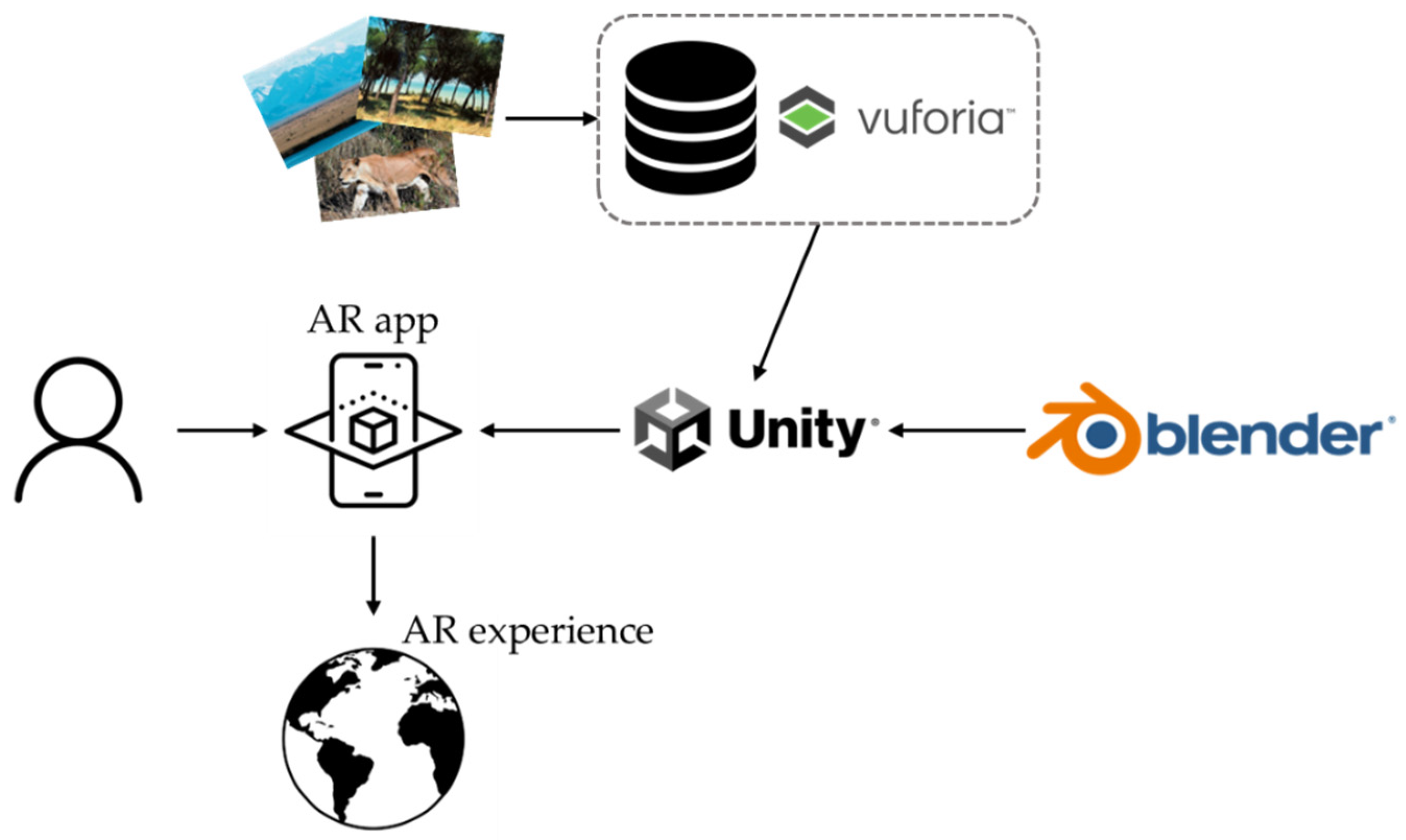
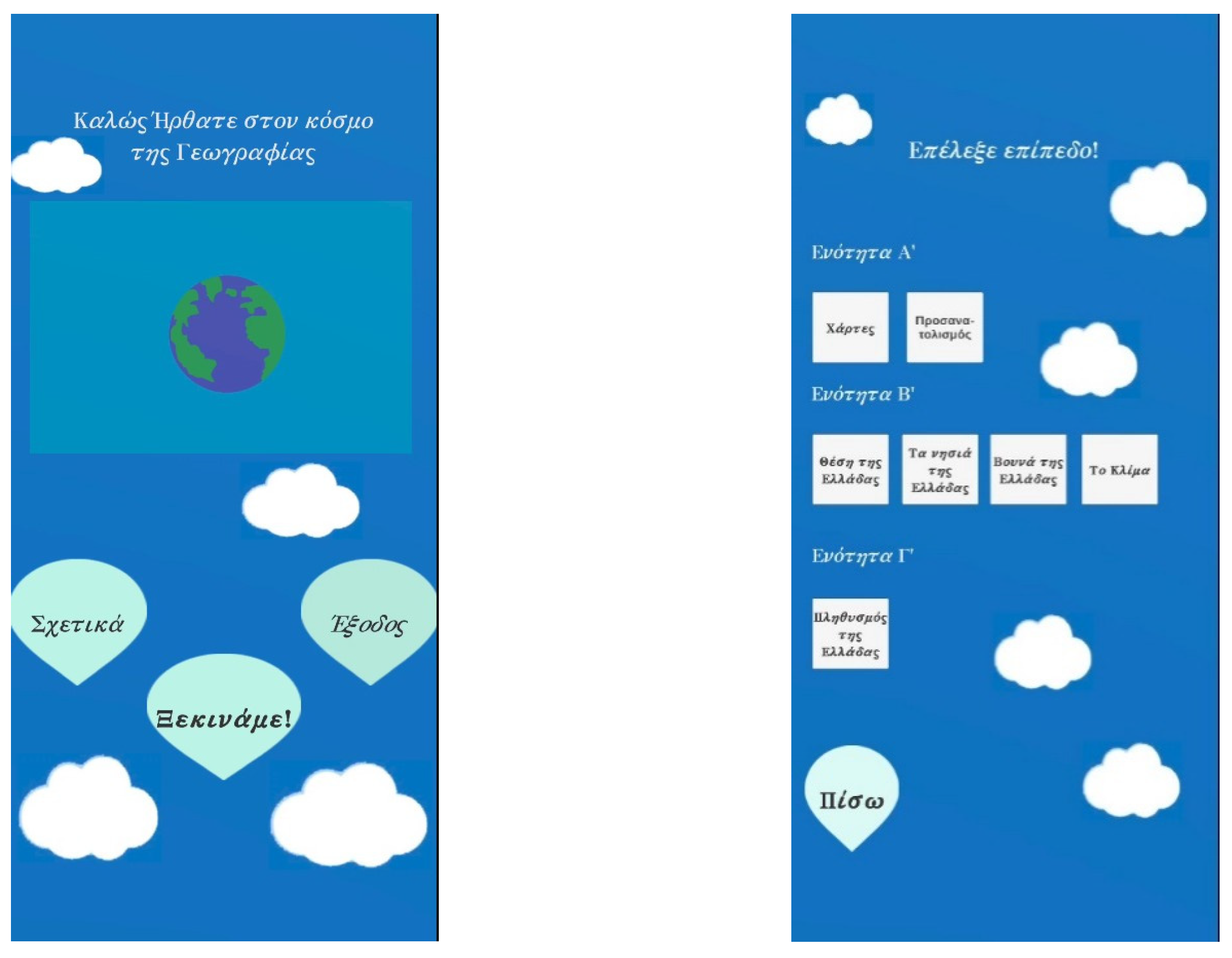
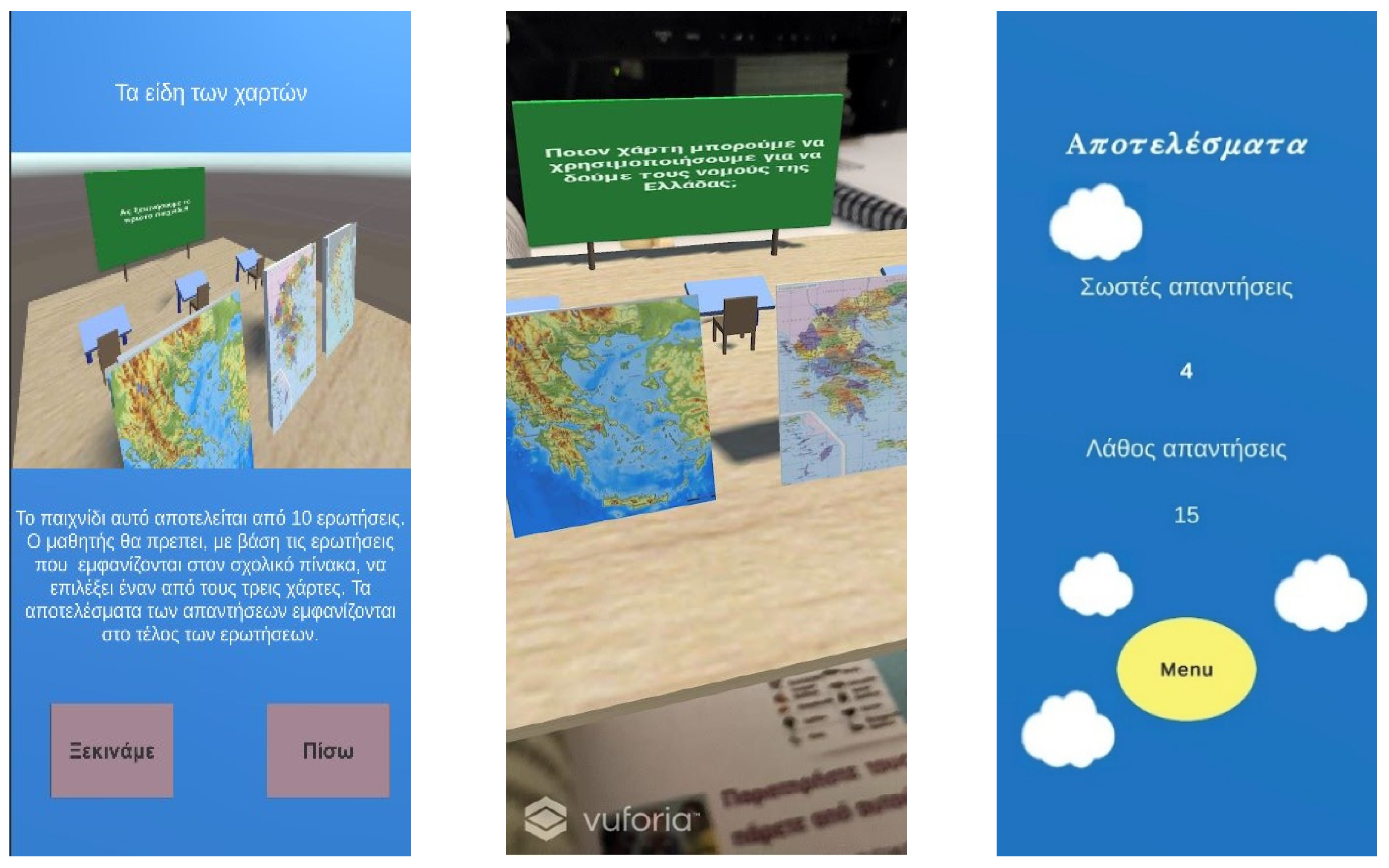
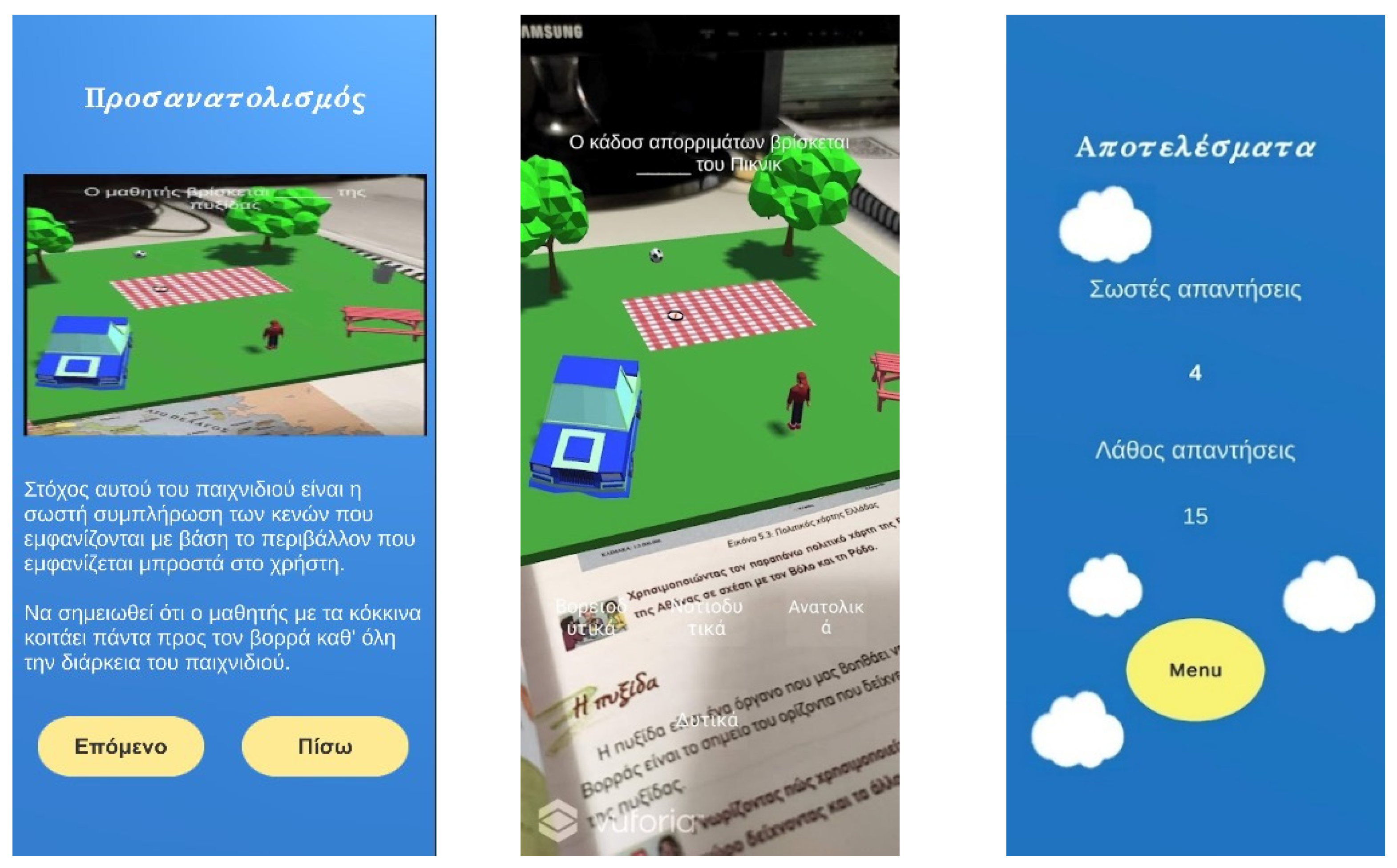
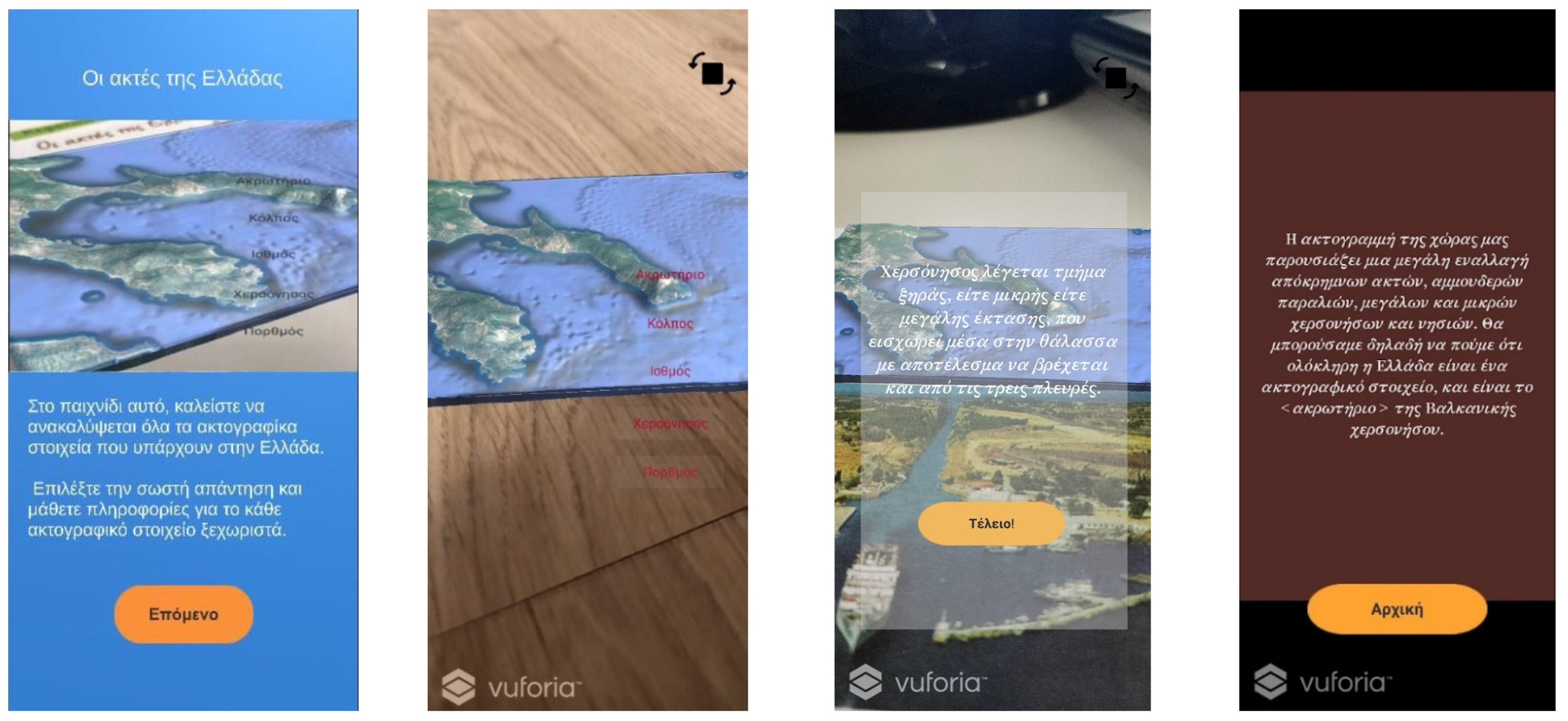
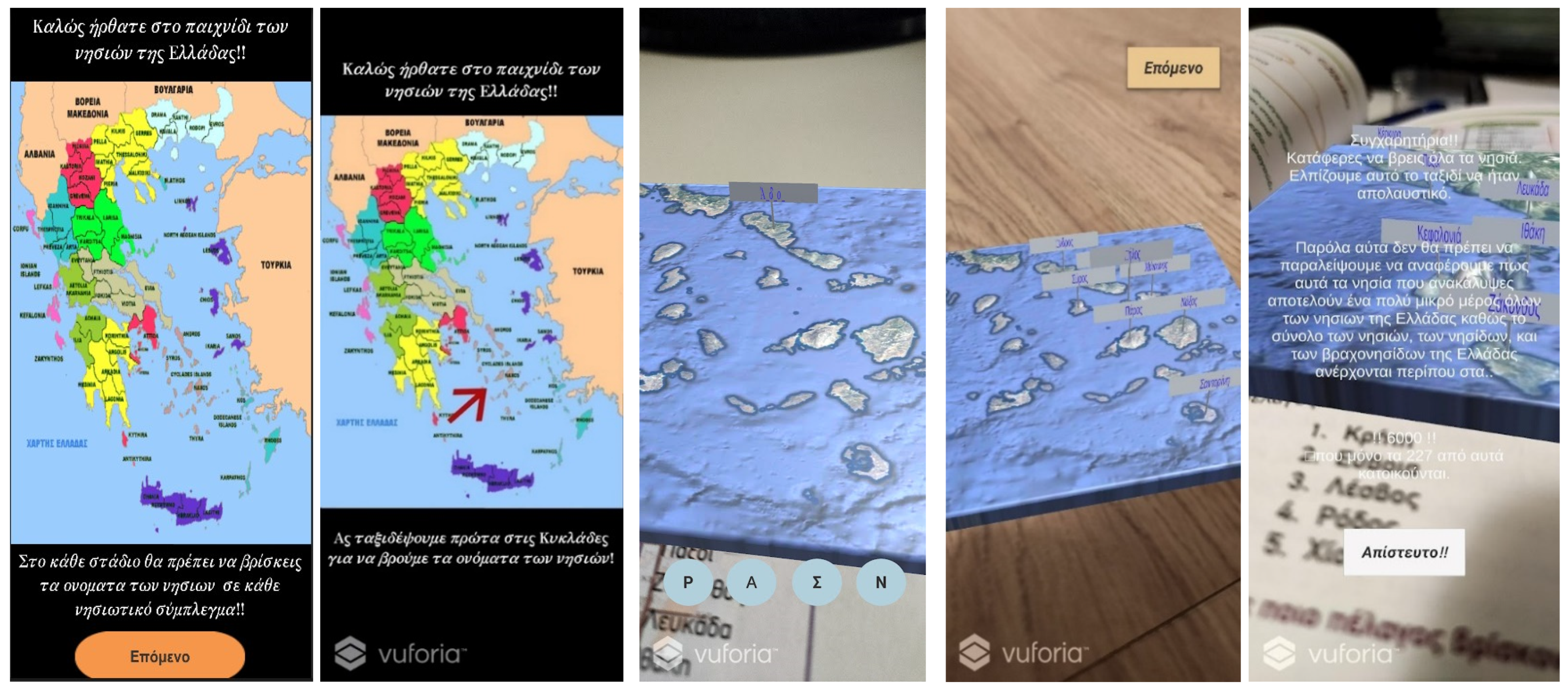
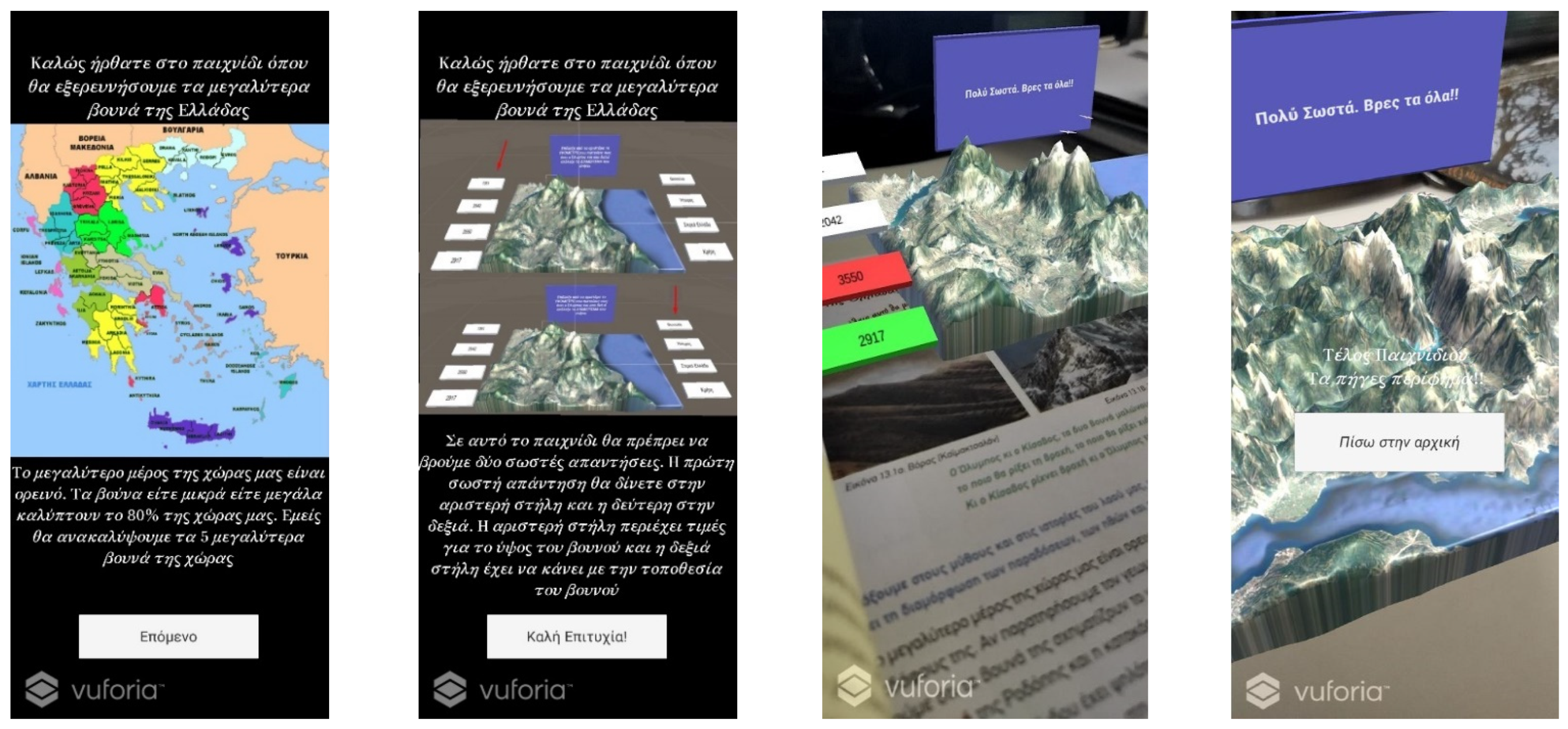
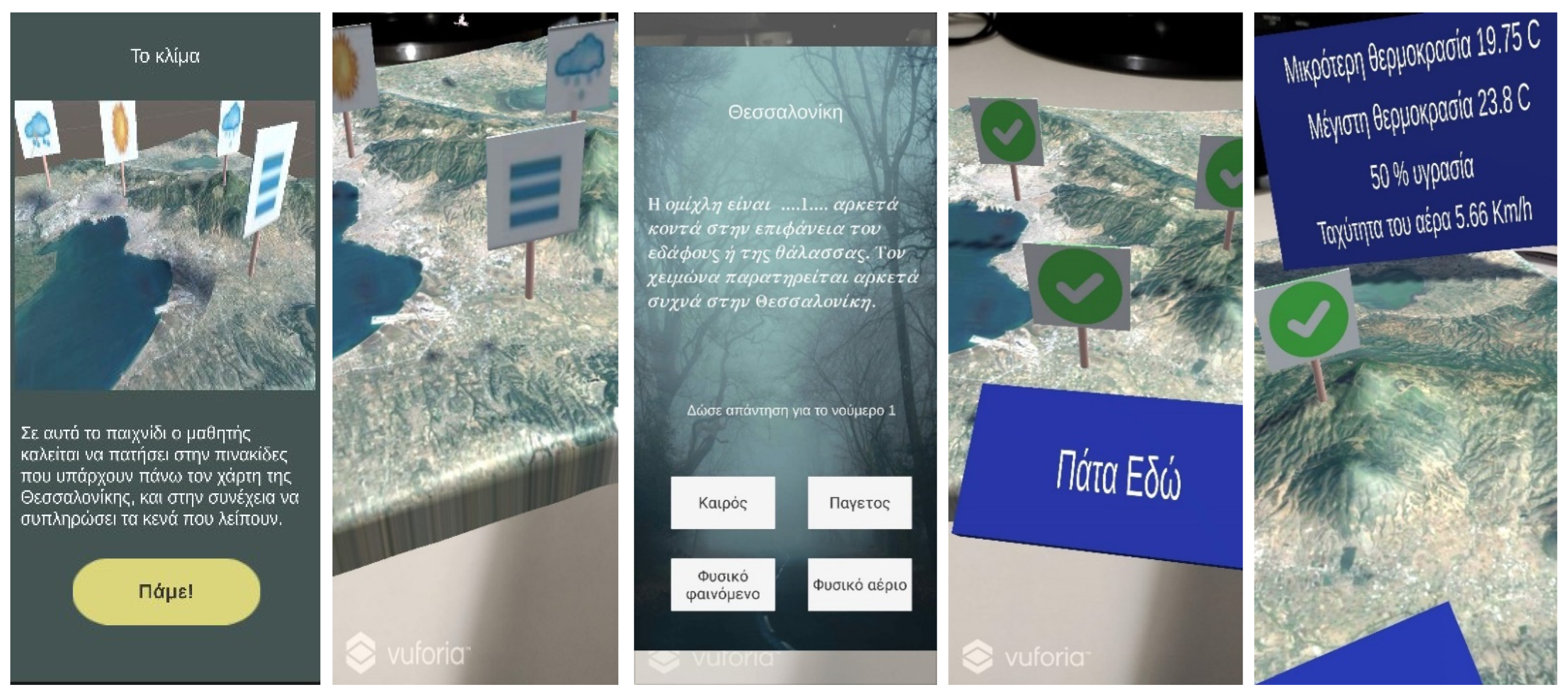
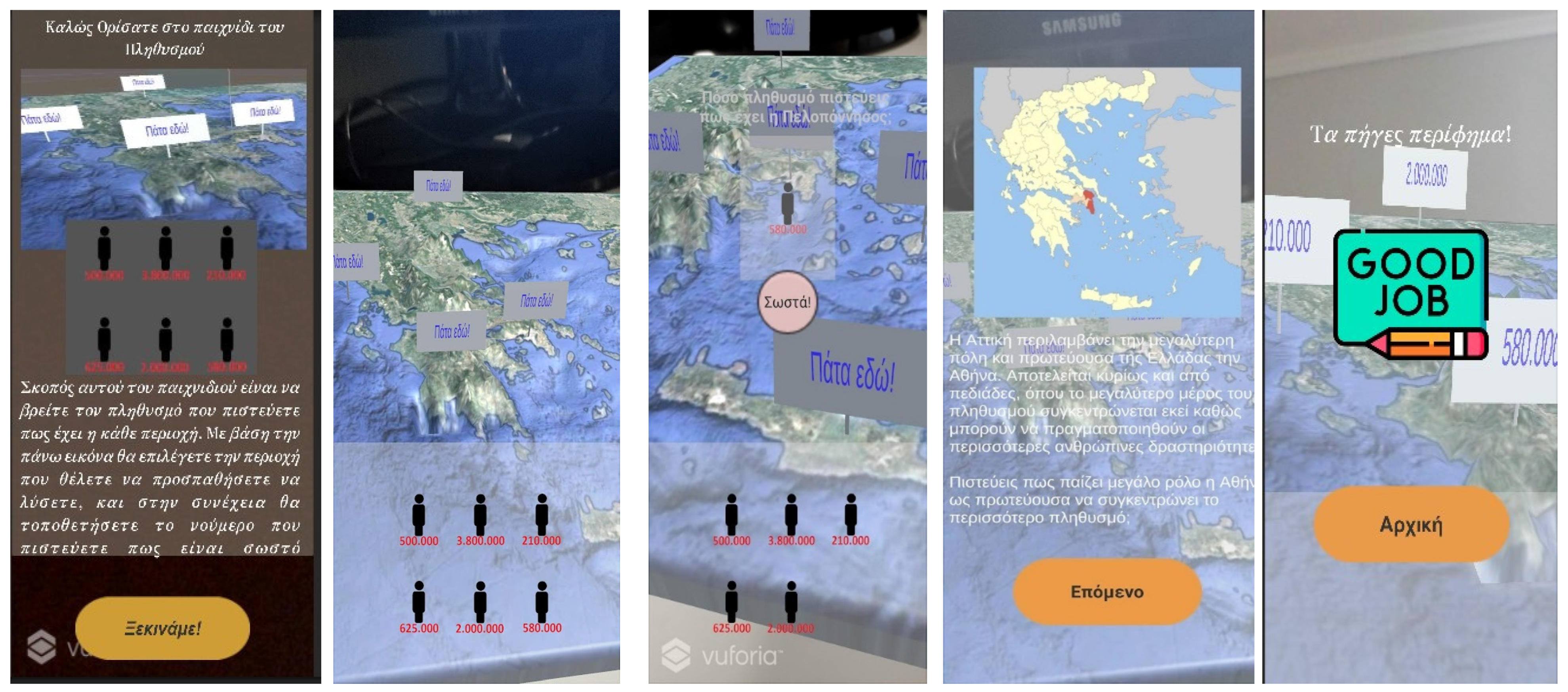
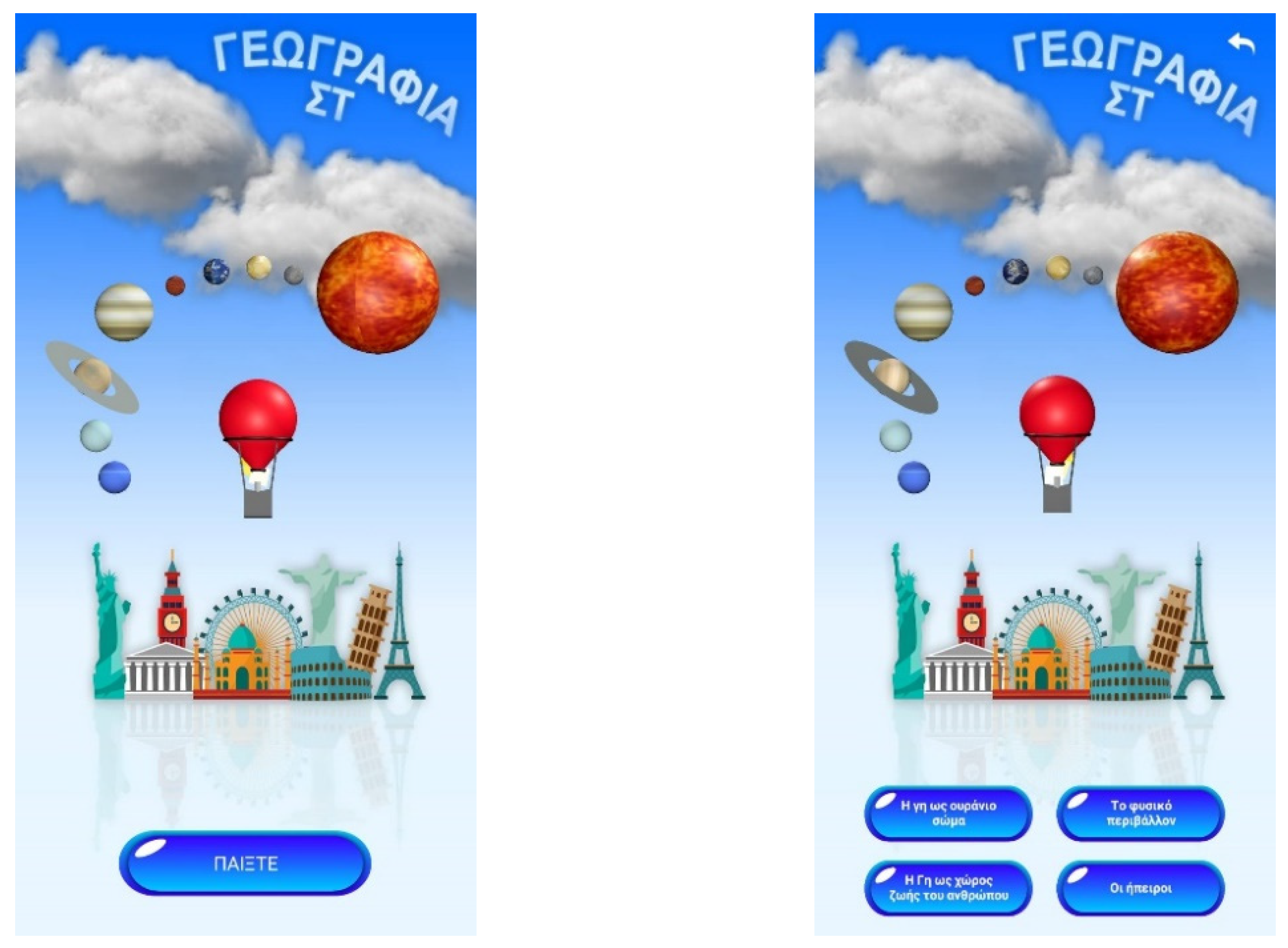

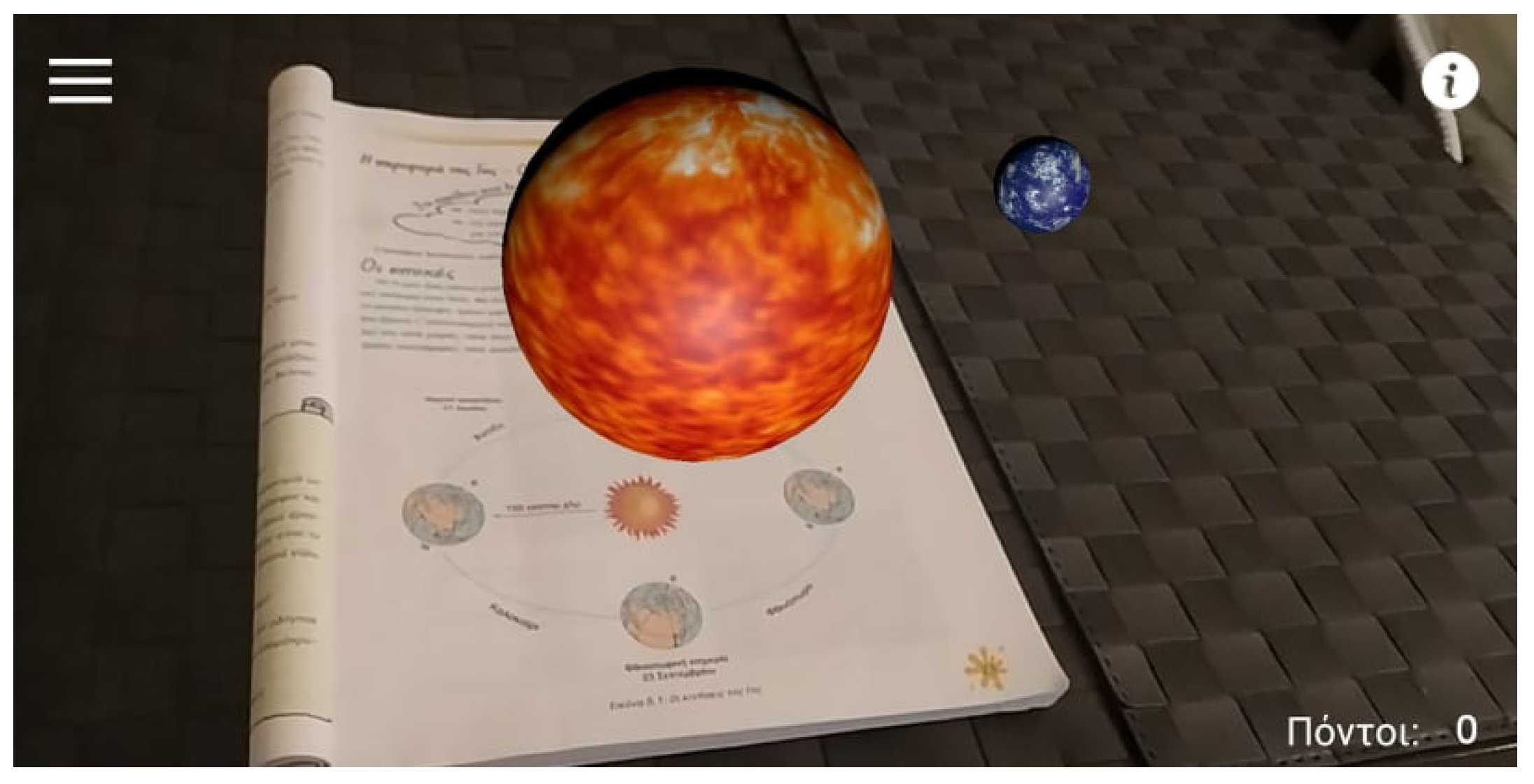
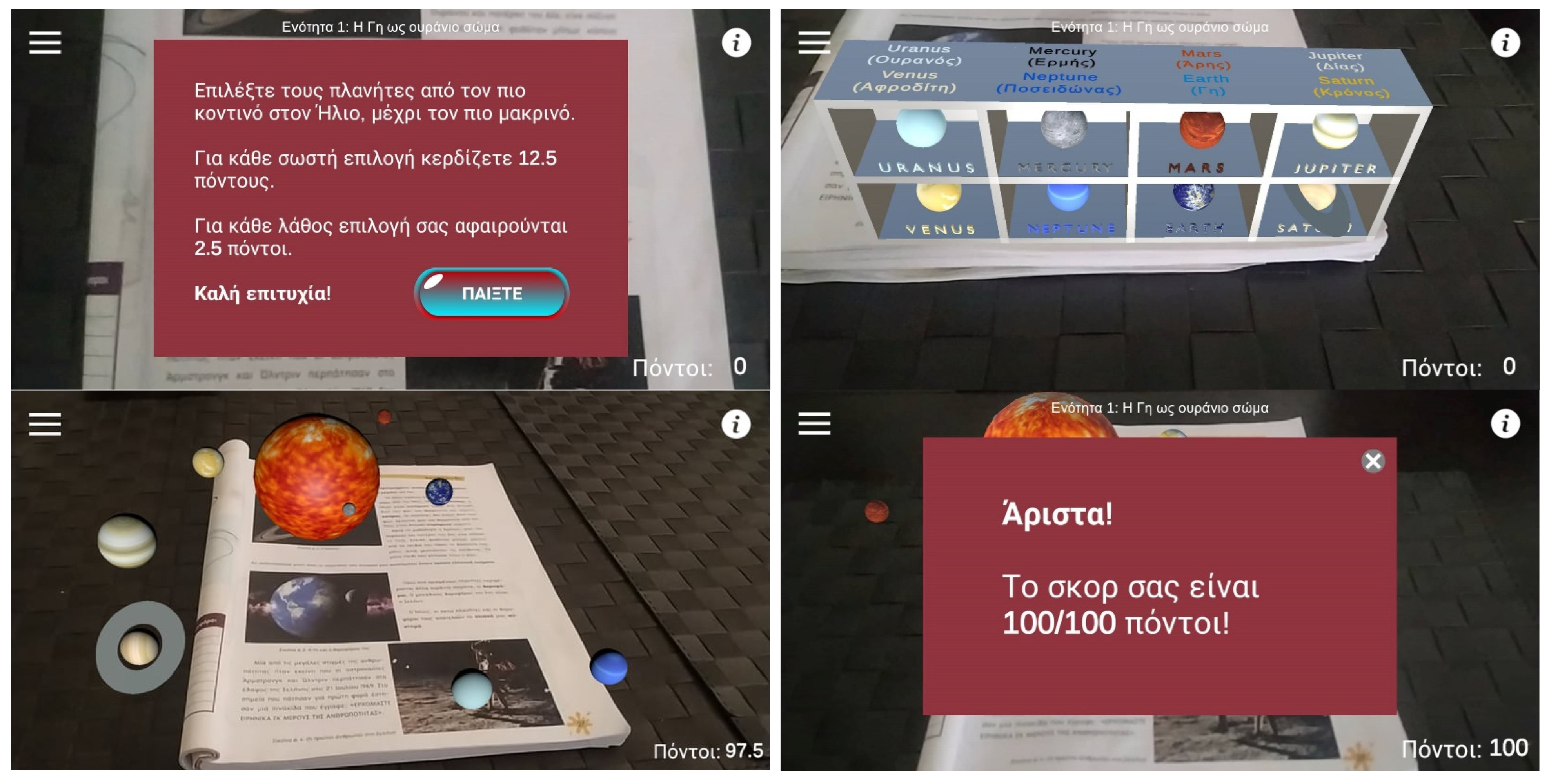
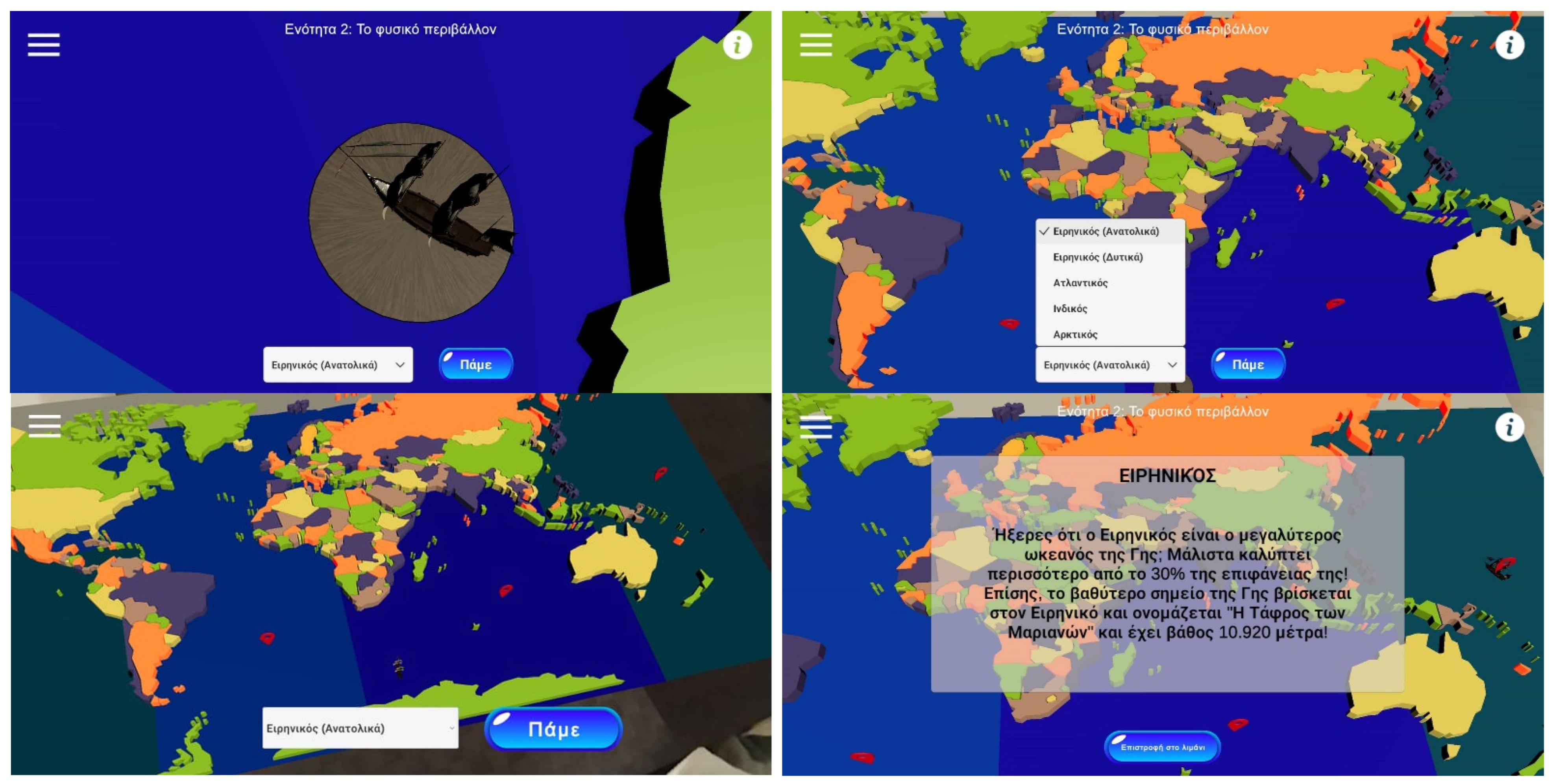

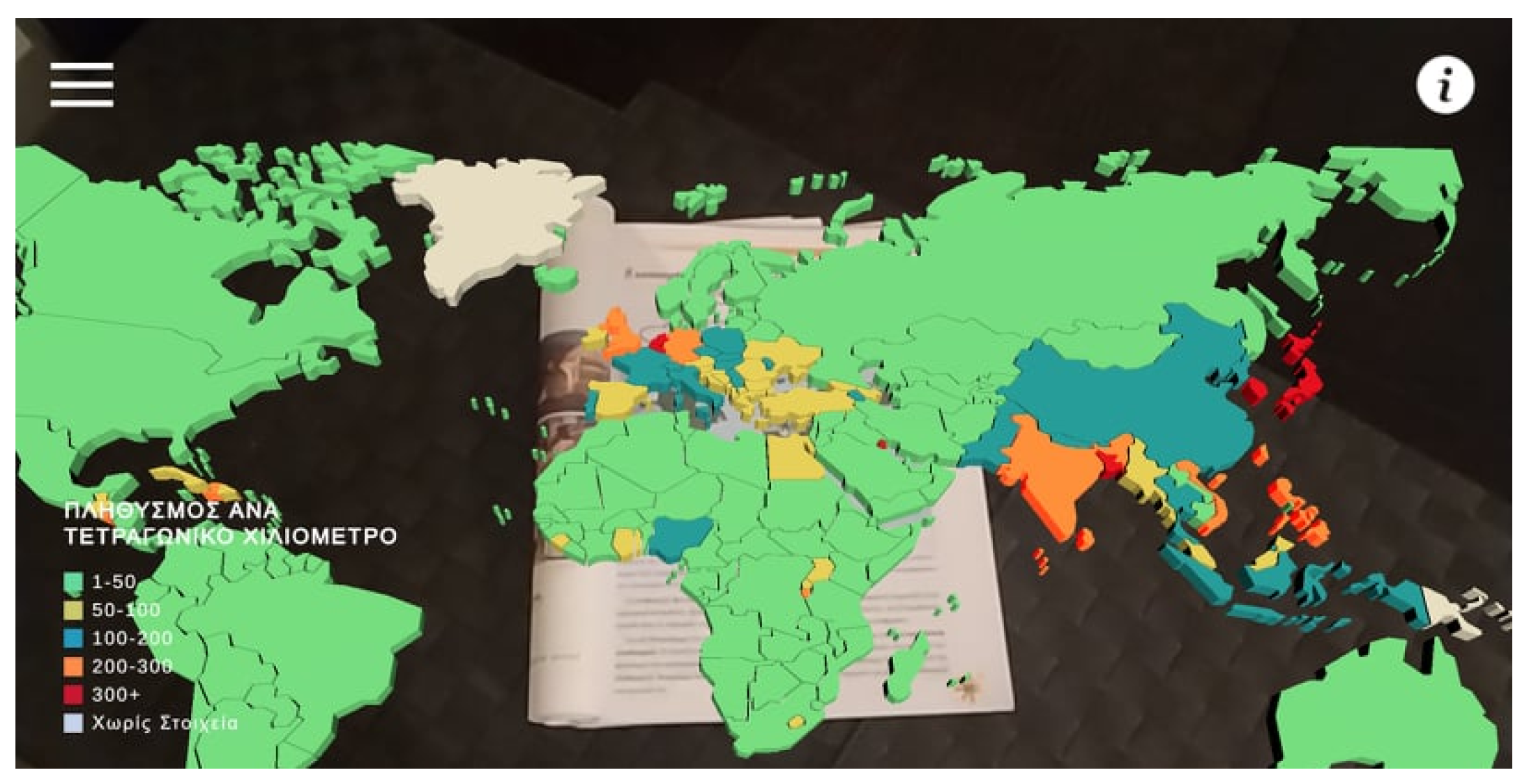


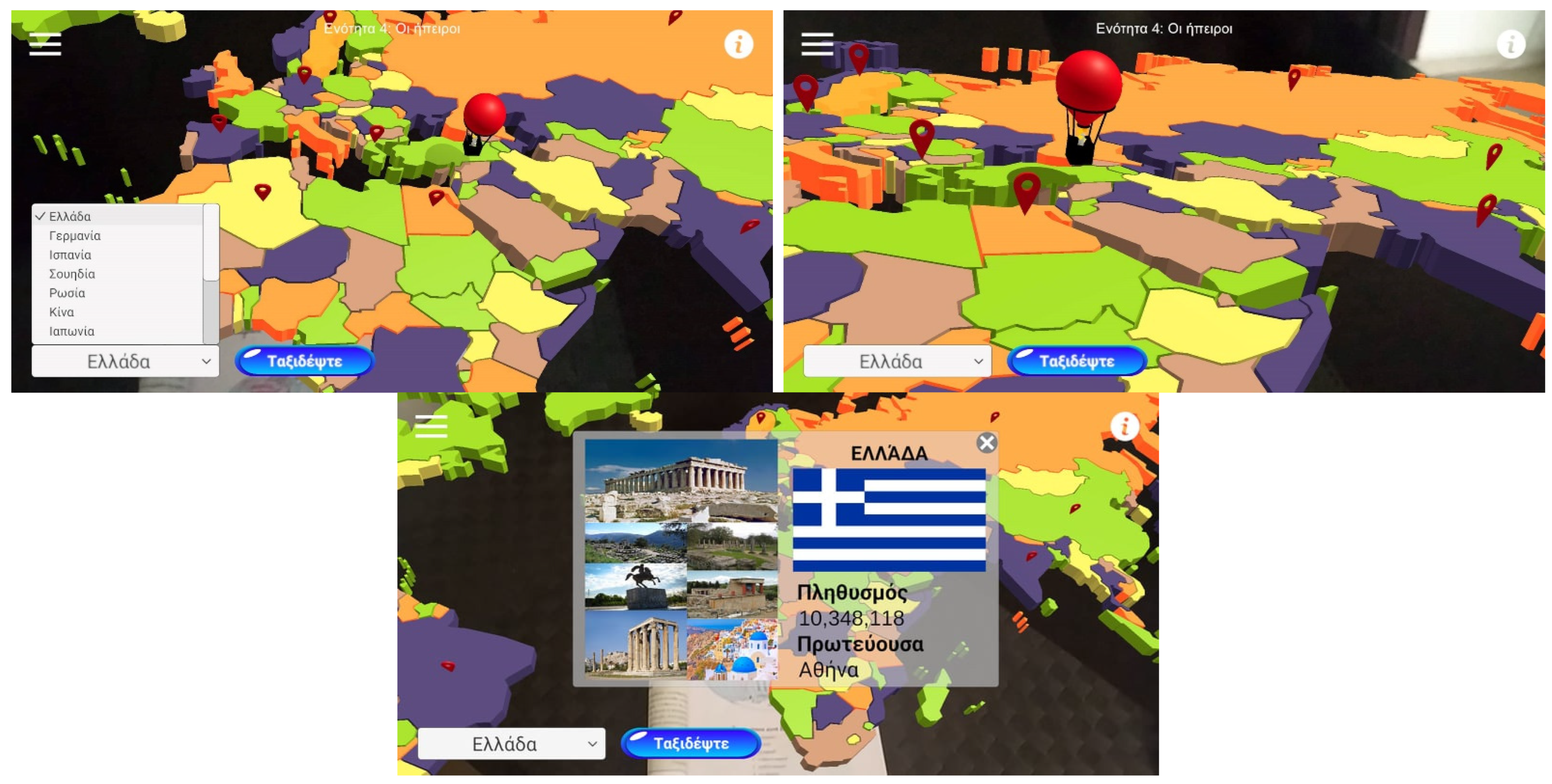
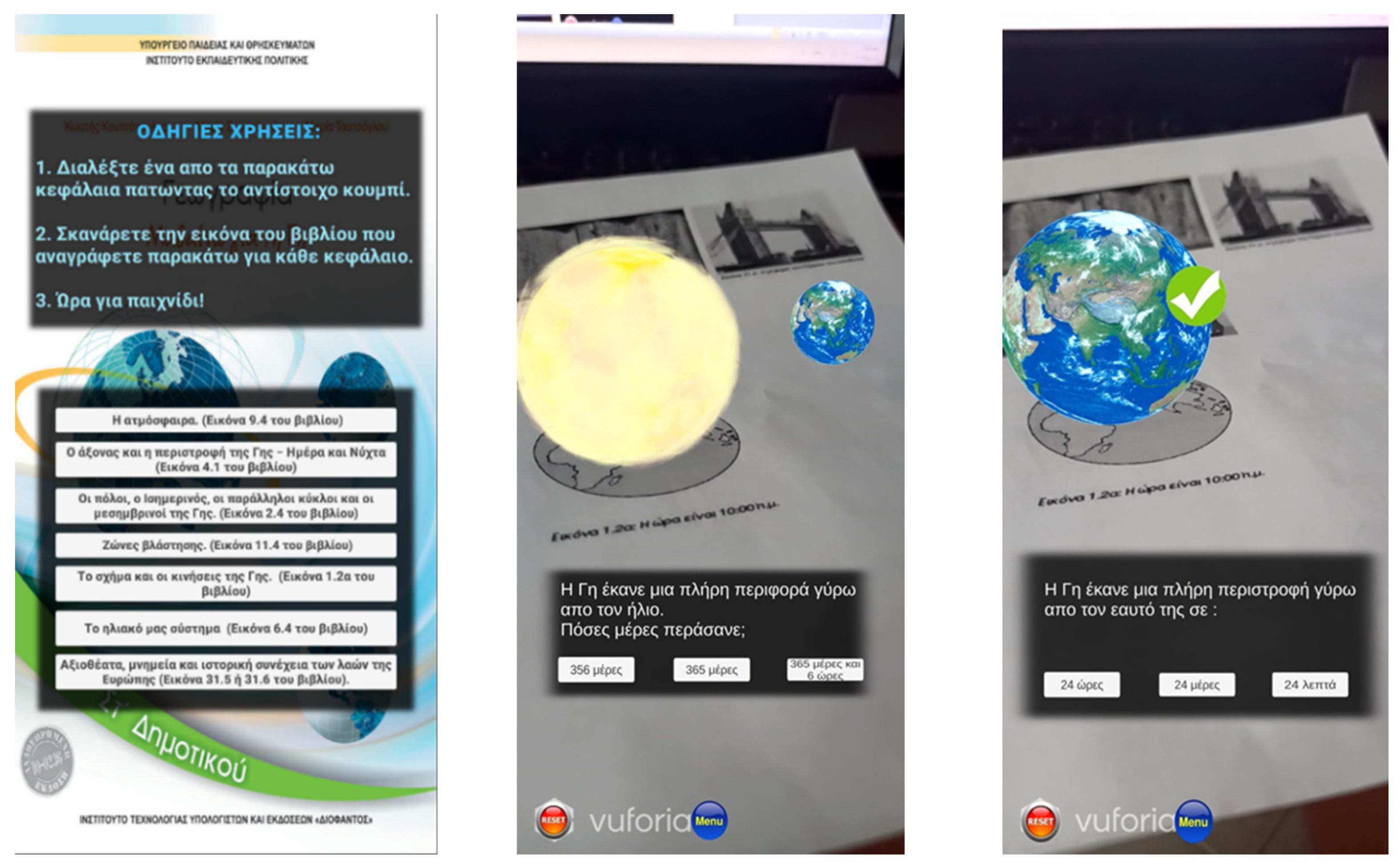
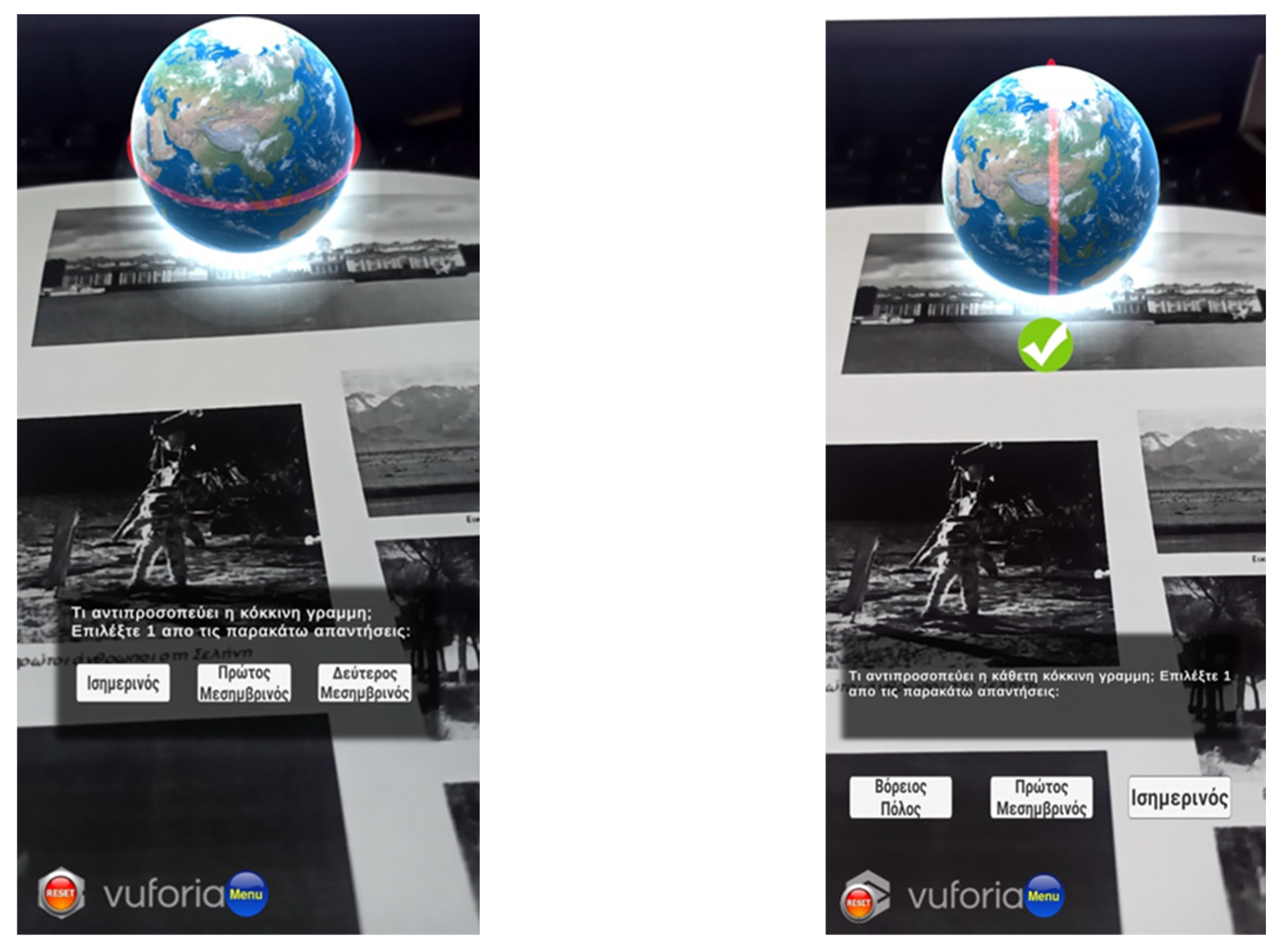
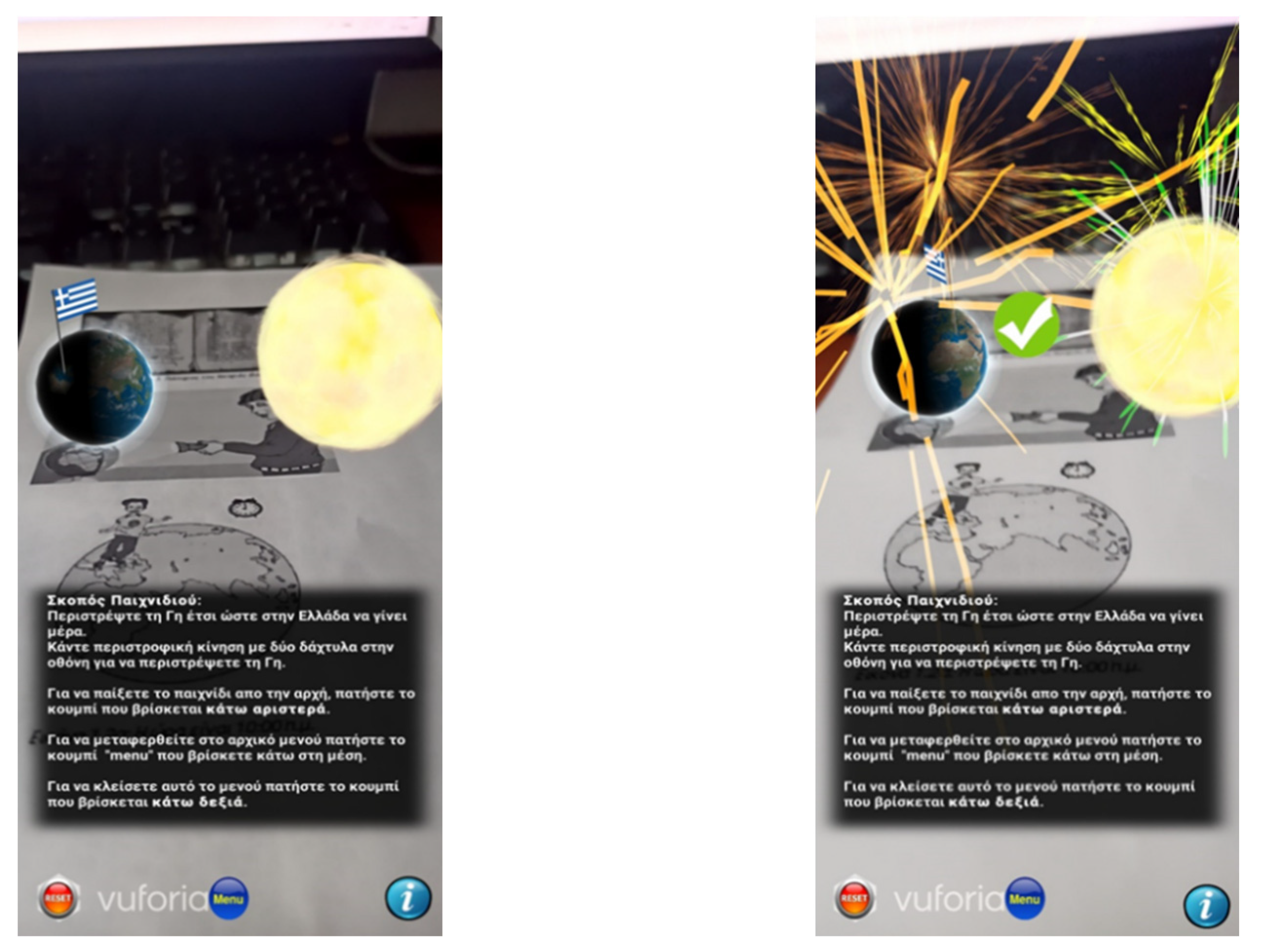
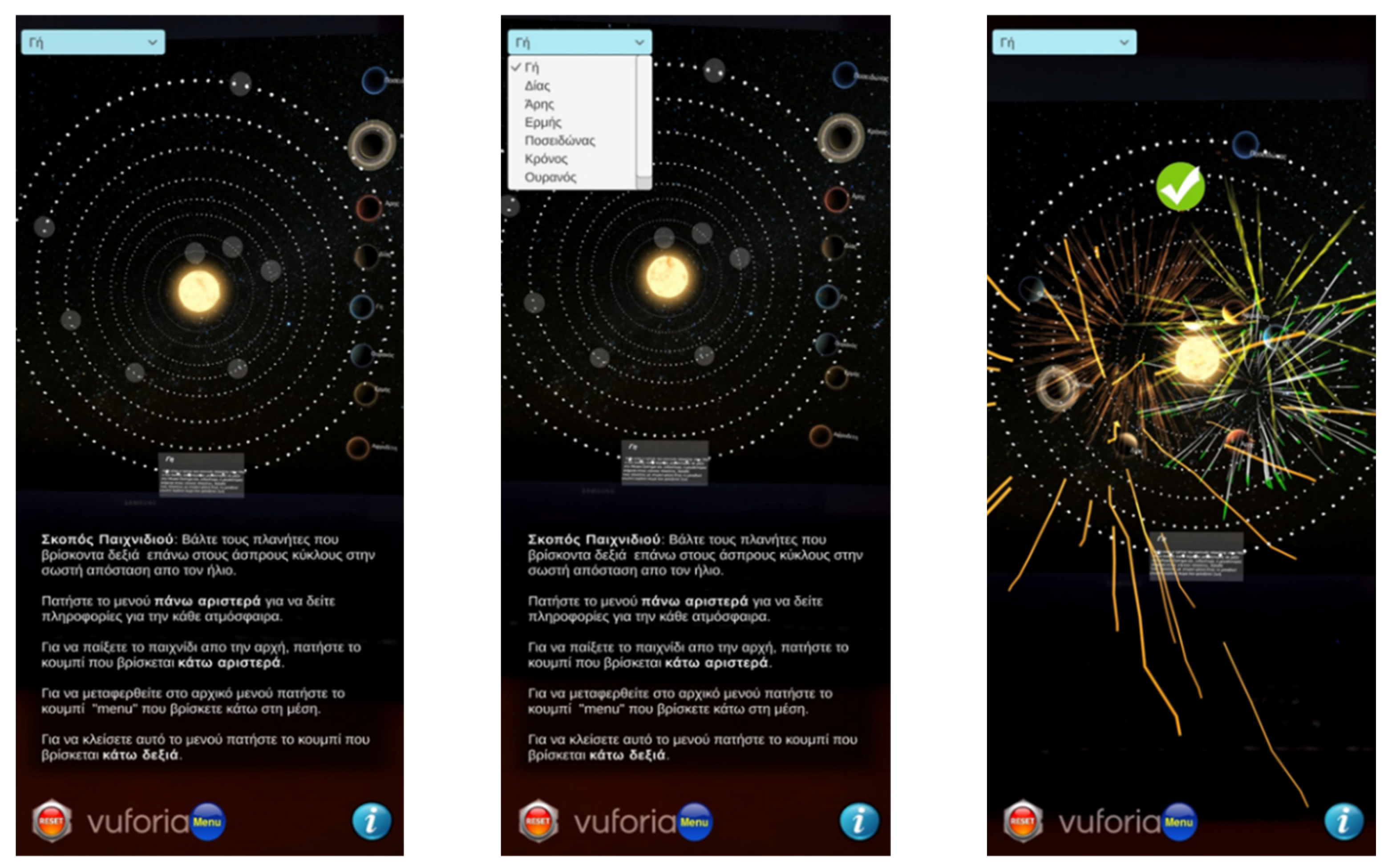

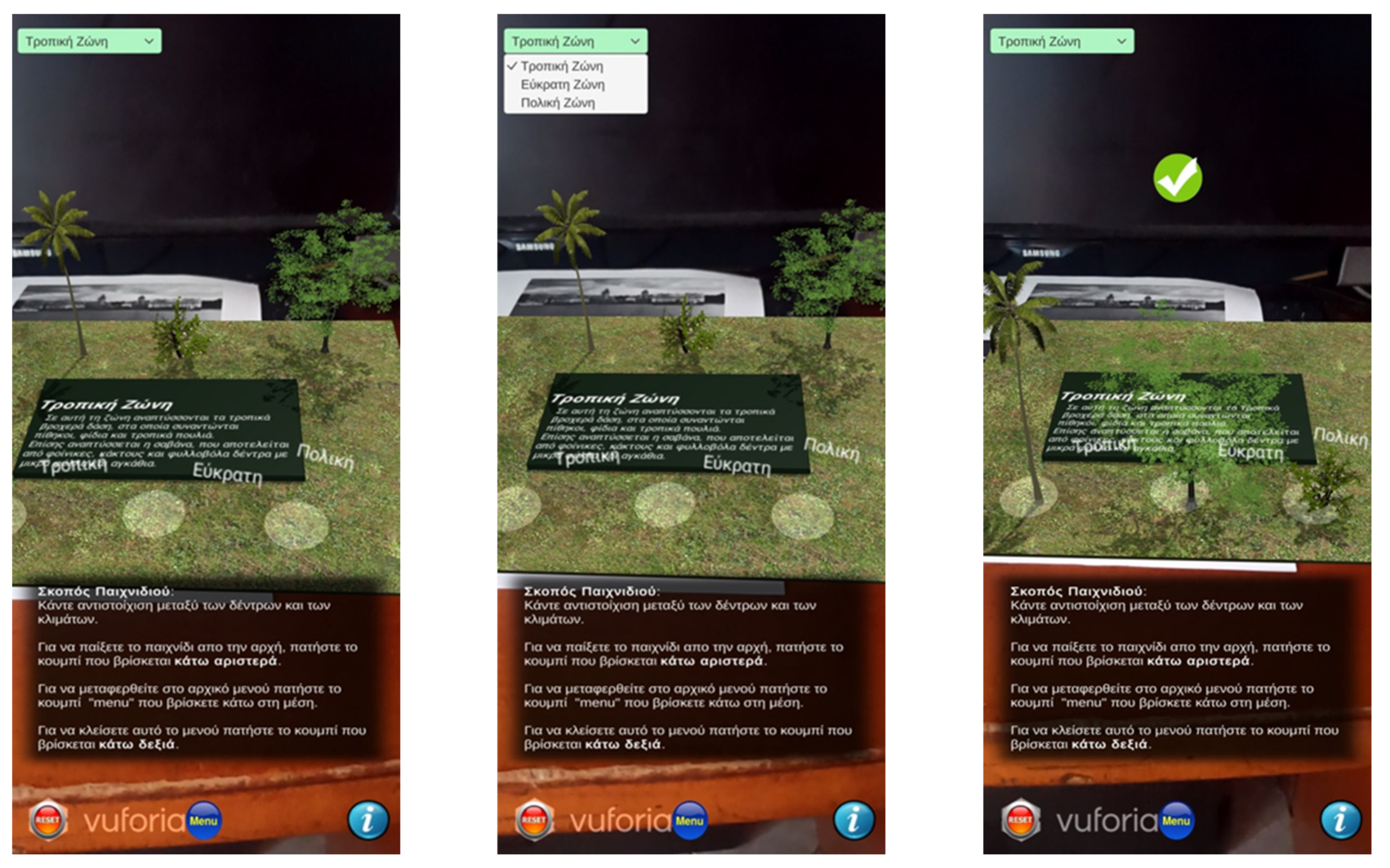
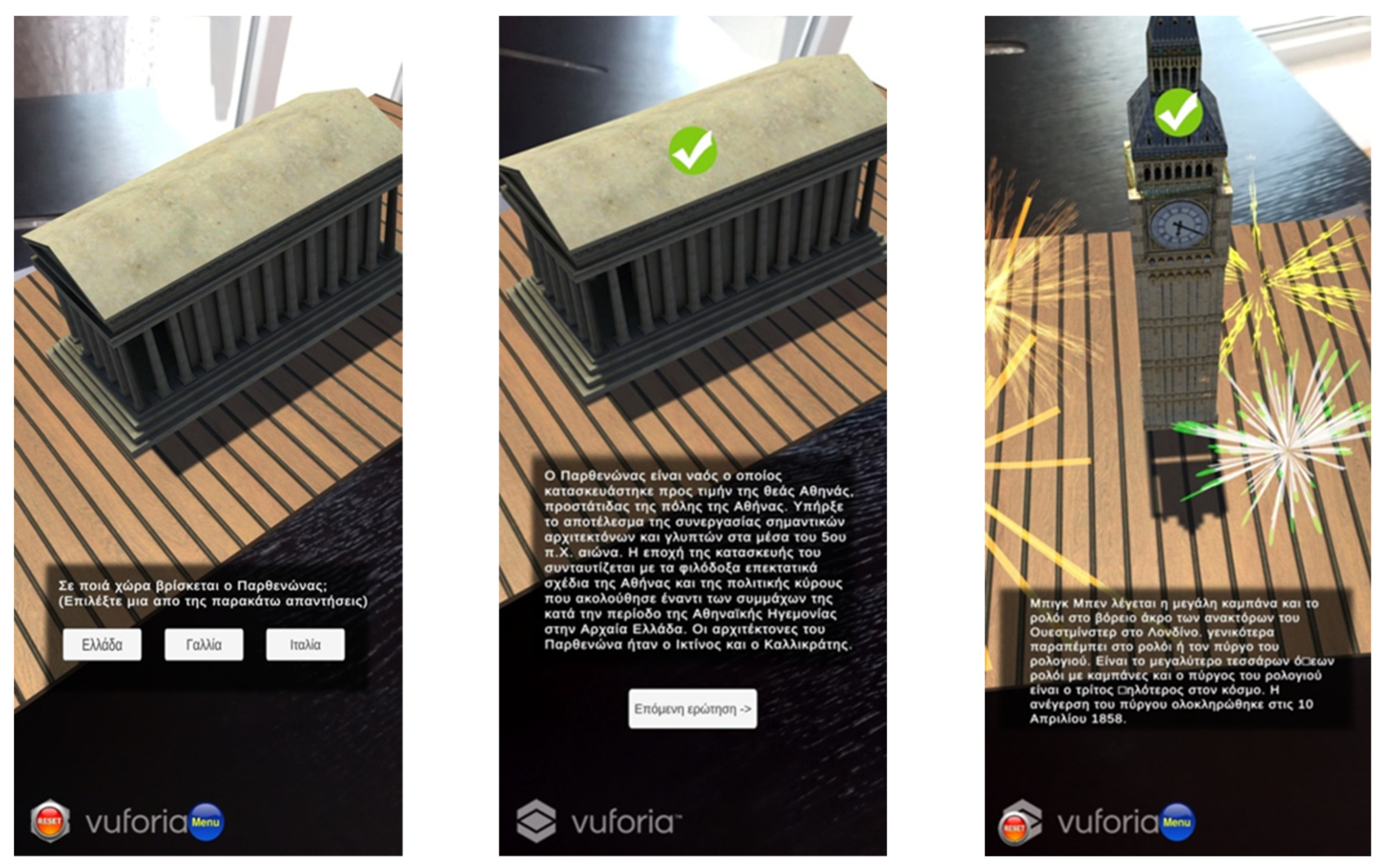

| 5th Grade AR App: Greece | 6th Grade AR app: Earth as a Living Space for Humans | 6th Grade AR App: Earth as a Celestial Body | Total | |
|---|---|---|---|---|
| Teachers | 2 | 2 | 2 | 6 |
| Pupils | 15 | 14 | 14 | 43 |
| Comp. Science Students | 43 | 43 | 43 | 43 |
| Total | 60 | 59 | 59 |
| 5th Grade AR App: Greece | 6th Grade AR App: Earth as a Living Space for Humans | 6th Grade AR App: Earth as a Celestial Body | |
|---|---|---|---|
| Teachers | 73.75 (SD 12.37) | 82.50 (SD 3.68) | 73.75 (SD 5.30) |
| Pupils | 70.50 (SD 15.98) | 70.00 (SD 14.61) | 76.07 (SD 9.69) |
| Comp. ScienceStudents | 82.26 (SD 11.47) | 85.87 (SD 12.12) | 77.44 (SD 18.54) |
| Total * | 79.04 (SD 13.57) | 81.99 (SD 14.15) | 76.99 (SD 16.47) |
| Item | English Version of SUS | Pupil Responses Mean (Std) | Teacher Responses Mean (Std) | Comp. Science Students Mean (Std) |
|---|---|---|---|---|
| Q1 | I think that I would like to use this system frequently. | 4.07 (1.03) | 4.50 (0.71) | 3.95 (0.87) |
| Q2 | I found the system unnecessarily complex. | 2.00 (0.93) | 2.50 (0.71) | 1.44 (0.55) |
| Q3 | I thought that the system was easy to use. | 4.00 (1.00) | 4.00 (0.00) | 4.23 (0.75) |
| Q4 | I think that I would need the support of a technical person to be able to use this system. | 2.40 (1.24) | 3.50 (0.71) | 1.65 (1.04) |
| Q5 | I found that the various functions in this system were well integrated. | 4.27 (0.88) | 4.50 (0.71) | 4.14 (0.71) |
| Q6 | I thought that there was too much inconsistency in this system. | 2.40 (1.06) | 2.50 (2.12) | 1.77 (0.95) |
| Q7 | I would imagine that most people would learn to use this system very quickly. | 3.73 (0.96) | 4.50 (0.71) | 4.51 (0.51) |
| Q8 | I found the system very cumbersome to use. | 2.13 (1.41) | 1.50 (0.71) | 1.46 (0.80) |
| Q9 | I felt very confident using the system. | 3.60 (0.99) | 4.00 (0.00) | 4.05 (0.87) |
| Q10 | I needed to learn a lot of things before I could get going with this system. | 2.53 (1.25) | 2.00 (0.00) | 1.65 (0.78) |
| Item | English Version of SUS | Pupil Responses Mean (Std) | Teacher Responses Mean (Std) | Comp. Science Students Mean (Std) |
|---|---|---|---|---|
| Q1 | I think that I would like to use this system frequently. | 3.43 (1.09) | 4.50 (0.71) | 4.00 (0.90) |
| Q2 | I found the system unnecessarily complex. | 2.57 (1.28) | 1.00 (0.00) | 1.39 (0.73) |
| Q3 | I thought that the system was easy to use. | 4.14 (0.86) | 4.50 (0.71) | 4.39 (0.62) |
| Q4 | I think that I would need the support of a technical person to be able to use this system. | 2.79 (1.19) | 3.50 (0.71) | 1.28 (0.50) |
| Q5 | I found that the various functions in this system were well integrated. | 3.93 (0.92) | 4.50 (0.71) | 4.26 (0.85) |
| Q6 | I thought that there was too much inconsistency in this system. | 2.14 (1.03) | 1.00 (0.00) | 1.56 (0.80) |
| Q7 | I would imagine that most people would learn to use this system very quickly. | 4.29 (0.62) | 4.50 (0.71) | 4.39 (0.62) |
| Q8 | I found the system very cumbersome to use. | 1.64 (0.84) | 1.00 (0.00) | 1.46 (0.70) |
| Q9 | I felt very confident using the system. | 3.64 (0.84) | 4.50 (0.71) | 4.42 (0.59) |
| Q10 | I needed to learn a lot of things before I could get going with this system. | 2.29 (0.99) | 3.00 (1.41) | 1.42 (0.66) |
| Item | English Version of SUS | Pupil Responses Mean (Std) | Teacher Responses Mean (Std) | Comp. Science Students Mean (Std) |
|---|---|---|---|---|
| Q1 | I think that I would like to use this system frequently. | 3.57 (1.16) | 4.50 (0.71) | 3.77 (1.00) |
| Q2 | I found the system unnecessarily complex. | 1.86 (1.03) | 2.50 (2.12) | 1.79 (0.91) |
| Q3 | I thought that the system was easy to use. | 4.36 (0.63) | 4.00 (0.00) | 3.93 (0.94) |
| Q4 | I think that I would need the support of a technical person to be able to use this system. | 2.21 (0.80) | 3.50 (0.71) | 1.74 (1.05) |
| Q5 | I found that the various functions in this system were well integrated. | 4.14 (0.66) | 4.50 (0.71) | 4.14 (0.74) |
| Q6 | I thought that there was too much inconsistency in this system. | 1.71 (1.07) | 1.50 (0.71) | 1.67 (0.99) |
| Q7 | I would imagine that most people would learn to use this system very quickly. | 4.14 (0.86) | 4.00 (0.00) | 4.02 (0.96) |
| Q8 | I found the system very cumbersome to use. | 1.43 (0.65) | 1.00 (0.00) | 1.79 (0.96) |
| Q9 | I felt very confident using the system. | 3.57 (1.09) | 4.00 (0.00) | 3.91 (0.92) |
| Q10 | I needed to learn a lot of things before I could get going with this system. | 2.14 (1.17) | 3.00 (1.41) | 1.79 (0.91) |
| 5th Grade AR App: Greece | 6th Grade AR App: Earth as a Living Space for Humans | 6th Grade AR App: Earth as a Celestial Body | |
|---|---|---|---|
| Teachers | 4.00 (SD 0.00) | 5.00 (SD 0.00) | 5.00 (SD 0.00) |
| Pupils | 3.93 (SD 0.70) | 3.71 (SD 0.65) | 4.07 (SD 0.92) |
| Comp. Science Students | 4.53 (SD 0.55) | 4.37 (SD 0.72) | 4.40 (SD 0.85) |
Publisher’s Note: MDPI stays neutral with regard to jurisdictional claims in published maps and institutional affiliations. |
© 2022 by the authors. Licensee MDPI, Basel, Switzerland. This article is an open access article distributed under the terms and conditions of the Creative Commons Attribution (CC BY) license (https://creativecommons.org/licenses/by/4.0/).
Share and Cite
Volioti, C.; Keramopoulos, E.; Sapounidis, T.; Melisidis, K.; Kazlaris, G.C.; Rizikianos, G.; Kitras, C. Augmented Reality Applications for Learning Geography in Primary Education. Appl. Syst. Innov. 2022, 5, 111. https://doi.org/10.3390/asi5060111
Volioti C, Keramopoulos E, Sapounidis T, Melisidis K, Kazlaris GC, Rizikianos G, Kitras C. Augmented Reality Applications for Learning Geography in Primary Education. Applied System Innovation. 2022; 5(6):111. https://doi.org/10.3390/asi5060111
Chicago/Turabian StyleVolioti, Christina, Euclid Keramopoulos, Theodosios Sapounidis, Konstantinos Melisidis, Georgios Christoforos Kazlaris, George Rizikianos, and Christos Kitras. 2022. "Augmented Reality Applications for Learning Geography in Primary Education" Applied System Innovation 5, no. 6: 111. https://doi.org/10.3390/asi5060111
APA StyleVolioti, C., Keramopoulos, E., Sapounidis, T., Melisidis, K., Kazlaris, G. C., Rizikianos, G., & Kitras, C. (2022). Augmented Reality Applications for Learning Geography in Primary Education. Applied System Innovation, 5(6), 111. https://doi.org/10.3390/asi5060111









